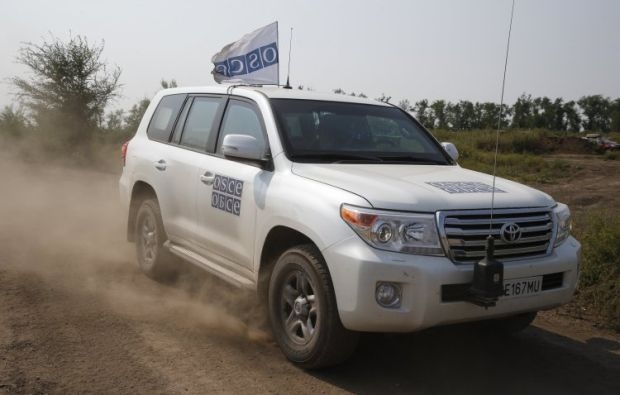
"In the early evening, an unmarked vehicle with four men and one woman wearing military-type uniforms passed an SMM patrol of two vehicles in Donetsk city. The civilian car suddenly, and without warning, swerved and braked in front of the SMM vehicles before driving away. Approximately 500m farther ahead the vehicle stopped in the middle of the road and turned on its emergency lights. The SMM attempted several times to turn into side streets but was blocked from doing so and the vehicle continued to shadow the patrol," the OSCE SMM said in an update based on information received as of 19:30 local time on May 8, 2016.
"On two occasions when the patrol stopped at traffic lights, the driver of the vehicle approached the SMM's vehicle and attempted to attach black and orange St. George ribbons to the SMM's vehicle. After approximately 20 minutes the civilian vehicle drove away," the report says.
Not long ago, a St. George ribbon made the headlines when a deputy in the Russian Duma, a member of the Communist Party of the Russian Federation, Pavel Dorokhin, asked Pope Francis to put on a St. George ribbon on May 5, 2016. Later a spokesperson for the Vatican press center said that Pope Francis could not know what the St. George ribbon stands for, as it is unknown outside the former Soviet Union.
The orange and black-striped ribbon known as the St. George ribbon in Russia first gained use as a propaganda tool as recently as on Victory Day on May 9, 2005.
The Interpreter studied the controversial history of the ribbon in detail last year and found out that according to one story told by the Russian independent media and Ukrainian media, the Kremlin's "grey cardinal," Vladislav Surkov, came up with the idea as a way of providing a patriotic alternative to the "Orange Revolution" and its orange ribbons in Ukraine. Fearful that the democratic movement might spread and undermine state power, Russian propagandists worked overtime to discredit and distract from the Ukrainian demonstrations and prevent them at home.
"But there's no question that where the St. George ribbon really began to get visibility and widespread use was in the Russian attack on Ukraine. Promoters or vendors with armfuls of St. George ribbons began appearing in the streets of Simferopol in February 2014 during pro-Russian demonstrations," the Interpreter wrote.
"When they first appeared in the spring of [2014] outside the context of Victory Day worn by Russian-backed militants, journalists didn't recognize what they were. Among the first times when the ribbons really began to stand out as a 'statement' was when Robert Serry, an envoy sent by the Swiss chair-in-office of the OSCE, was detained by the militants [on March 5, 2014]," it said.

